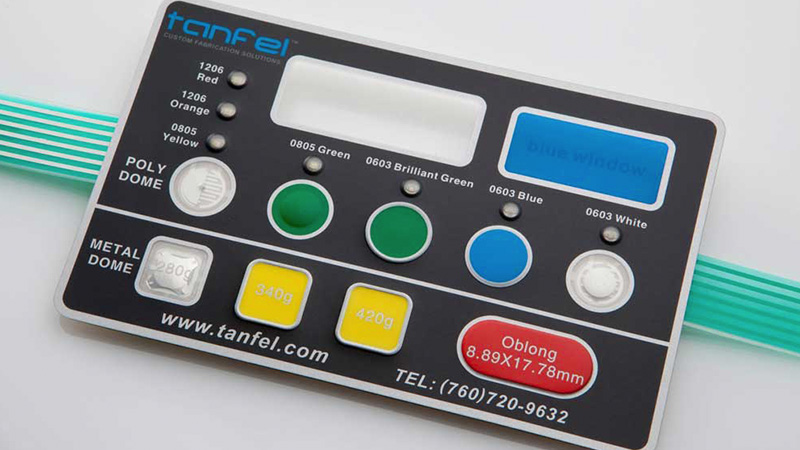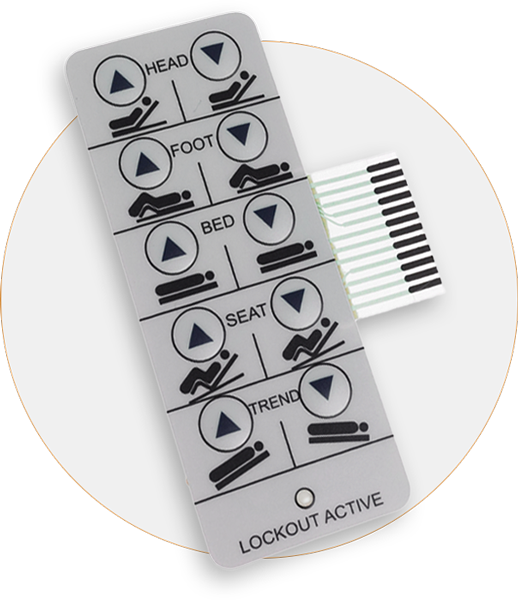Why Membrane Switches Are Necessary for Creating Space-Saving, Durable Interfaces
Why Membrane Switches Are Necessary for Creating Space-Saving, Durable Interfaces
Blog Article
Membrane Switch Modern Technology: The Trick to Trustworthy and Cost-Effective User Interfaces
Membrane button technology has become an essential part in the style of individual interfaces, supplying both dependability and cost-effectiveness throughout a diverse array of applications. Its durable construction ensures resistance to ecological obstacles, while the versatility in style enables customized remedies that meet particular sector demands. As we discover the complex benefits of membrane buttons, their potential for innovation questions about future applications and progressing trends. What does the next chapter hold for this modern technology in an increasingly digital landscape?
Comprehending Membrane Switch Over Technology
Membrane layer button modern technology is an extensively utilized interface option in different electronic tools, supplying a seamless blend of performance and layout. This modern technology includes numerous layers of products, typically including a graphic overlay, spacer layer, and a circuit layer. The visuals overlay presents the interface components, while the spacer layer divides the circuit layer from the overlay up until a customer activates a switch.
When stress is used to the overlay, the circuit layer finishes the electrical circuit, sending a signal to the tool. This mechanism permits different arrangements, consisting of responsive feedback and backlighting choices, improving customer communication. Membrane switches are usually manufactured using long lasting materials such as polyester or polycarbonate, making certain long life and resistance to environmental aspects like dampness and dust.
The convenience of membrane layer switches over enables their application in diverse markets, including medical devices, customer electronics, and commercial controls. Their small layout enables combination right into space-constrained environments, providing an effective customer interface without endangering aesthetic allure. Recognizing the intricacies of membrane layer switch technology is crucial for suppliers and developers seeking to create trusted and reliable human-machine interfaces.
Key Benefits of Membrane Layer Switches
While various user interface services exist, membrane layer switches offer distinctive advantages that make them a recommended choice in various applications. Among the primary advantages is their durability; membrane layer buttons are developed to stand up to extreme ecological conditions, including wetness, dust, and temperature level fluctuations, guaranteeing lasting efficiency. This resilience dramatically lowers the demand for frequent substitutes, therefore lowering general maintenance prices.

In addition, membrane layer buttons are lightweight and small, making them ideal for applications where room is restricted. Their low-profile style adds to a sleek appearance without compromising performance.
Cost-effectiveness is additionally a noteworthy benefit, as the production process for membrane switches has a tendency to be less expensive contrasted to conventional mechanical buttons. This affordability, combined with their dependability and ease of installment, placements membrane layer changes as a sensible remedy for a large range of sectors looking for effective and reliable interface.
Applications Throughout Numerous Industries
Exactly how do pop over to this site membrane layer switches adapt to the varied demands of various markets? Membrane button innovation is significantly identified for its adaptability, making it suitable for a wide variety of applications throughout several fields. In the medical field, membrane layer switches are made use of in analysis devices and client tracking gadgets, where their sturdiness and ease of cleansing are critical for preserving hygiene requirements. The automotive market utilizes these buttons in dashboards and control panels, using a structured aesthetic while ensuring user-friendly procedure.
In customer electronics, membrane buttons supply a portable service for remotes and home appliances, enhancing user experience through intuitive design. Furthermore, the industrial sector leverages membrane switches for equipment control panels, taking advantage of their resistance to extreme atmospheres, such as dampness and dirt.
Military and aerospace applications likewise utilize membrane layer switches for their integrity and capacity to hold up against extreme conditions, ensuring operational effectiveness in critical scenarios. In addition, the food and drink sector embraces these switches for automated systems, where hygiene and ease of operation are vital. Ultimately, membrane buttons are customized to fulfill the special needs of each sector, showing their vital role in contemporary technology user interfaces
Style and Personalization Alternatives

In the realm of membrane layer button innovation, layout and personalization alternatives play a pivotal duty in enhancing functionality and customer interaction. These buttons can be customized to meet certain functional requirements and aesthetic preferences, making them functional parts in various applications.
One of the key modification options is the design of the button itself, which can be developed to suit unique individual interfaces and ergonomic factors to consider. By adjusting the form, size, and arrangement of switches, makers can produce user-friendly styles that promote simplicity of use. In addition, the consolidation of various shades and graphic overlays enables branding and boosted visibility, guaranteeing that customers can promptly recognize functions.
Additionally, membrane switches can be crafted with numerous tactile responses devices, such as elevated switches or audible clicks, to improve the individual experience. Different materials can likewise be selected for durability and environmental resistance, resolving aspects such as dampness, temperature level changes, and chemical direct exposure.
Eventually, the substantial style and customization alternatives offered in membrane layer button technology encourage companies to create tailored solutions that not just fulfill functional demands yet likewise align with their branding and functional requirements.

Future Patterns in Membrane Buttons
As membrane layer button innovation proceeds to advance, future trends are progressively focused on improving individual experience and integrating advanced functionalities. One considerable trend is the combination of touch-sensitive look at here now and capacitive modern technologies right into standard membrane layer switches. This advancement permits even more user-friendly interface, offering tactile feedback while keeping a smooth layout.
One more emerging trend is making use of eco pleasant products, Recommended Site driven by the expanding need for sustainable manufacturing techniques. Makers are looking for to reduce their carbon impact by using recyclable substratums and low-impact inks, lining up with global sustainability goals.
In addition, the increase of the Web of Points (IoT) is prompting the unification of smart attributes right into membrane buttons. Enhanced connection choices will enable tools to connect with each various other, permitting smooth assimilation right into more comprehensive systems.
In addition, advancements in printing innovations, such as digital printing, are permitting higher design versatility and customization. This allows suppliers to generate intricate layouts and vivid shades cost-effectively.

Final Thought
Finally, membrane button innovation represents a crucial innovation in interface layout, supplying substantial benefits in resilience, personalization, and cost-effectiveness. Its prevalent applicability throughout varied industries underscores its significance in modern technology. As innovations proceed to arise, especially in touch-sensitive user interfaces and sustainable materials, the possibility for membrane layer switches to enhance customer experience and capability stays encouraging. Proceeded exploration of this technology will likely produce additionally improvements and widen its extent in future applications.
Report this page